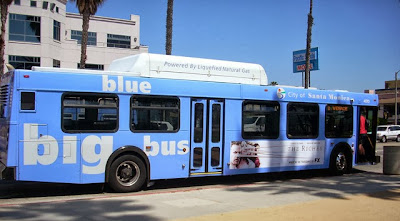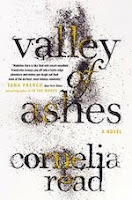I once told a friend that I used public transportation, most notably the Santa Monica Big Blue Bus. She stared at me in disbelief and then laughed nervously. Until that moment, I didn’t realize the perception of some Los Angeles Westsiders was that public transportation is an alien concept.
 |
| The Big Blue Bus |
My mother never learned to drive a car, so growing up in Washington I always took the bus. When I moved to Seattle, I had a job on Queen Anne Hill where parking was street only and hard to find, so I took the bus to work, even though going home I had to transfer on a corner in downtown that after dark was junkie central. I never had a problem and never thought much about my personal safety. (Ah, youth)
The easiest subway to understand and navigate is the London Tube. Tokyo’s subway is a cookie cutter version of the Tube. Despite the language barrier, I was able to travel throughout the city by myself. Moscow’s subway was scrupulously clean, its walls covered with heroic worker art. Los Angeles is late to the party but it's in the process of building a light rail network that has been decades in the making. It will take several more years before a station reaches me but I see promising signs: some streets are now clogged with overpass construction.
The closest station to me is the Expo Line in Culver City. For a while I’ve been thinking about taking a ride to see how it works. Friday I finally did it. I wasn't sure where the station was, so I made a test run that morning to scope out the terrain. It wasn’t easy to find due to lane closures and construction. The park-and-ride lot was free, clean, well lit and nearly full. There are no paper tickets. You have to buy a plastic “tap” card for a buck. I think it’s like a debit card, i.e., you buy “credit” to add to it. I’m sure it’s easy when you know how to use it—and I thought I did—but the instructions weren’t all that clear as you will later read.
 |
| Expo Line |
Friday night I had tickets to see Danny DeVito and Judd Hirsch in The Sunshine Boys at the Ahmanson Theatre (wonderful!). To make sure I got there for the 8:00 p.m. curtain and a pre-show taco, I caught the 5:57 p.m. Expo Line train to the 7th Street/Metro Center Station and transferred to the Red Line headed for Civic Center Station. Both trains were full of mostly young people from various walks of life, including some walks I wouldn’t have taken. The route took me through parts of the city I had never seen before.
 |
| Now playing at the Ahmanson Theatre in Los Angeles |
Along the route, threatening signs warned me to tap, tap, tap my tap card at every turn and I ended up tapping away all my “credit” for the return trip. (Do you have to “tap” when you transfer? Nobody’s saying.) This exposed one of my pet peeves: If you’re writing instructions, you should assume people know nothing about the subject. If they do, they can skip ahead. If they don't, they'll know what the heck they're supposed to do.
After exiting at Civic Center Station, I strolled through the lovely Grand Park to get to the Music Center. That’s when I began to wonder whether the park would be as lovely at 11:00 p.m. when I had to walk back to the station in total darkness. I also worried who would be riding the train on the return trip to Culver City.
I’m happy to report that the park was just as lovely going back and all the young people who shared my car were mostly well behaved except for the four twenty-something guys hawking and spitting chewing tobacco into potato chip bags.
There’s the bottom line:
- Train trip cost: $6.50 roundtrip because I over tapped. Should have cost $1.50 each way plus $1 for the card.
- Train travel time: 1 hour and 15 minutes
- Drive trip cost: $5.00 gas (estimate) plus parking at the theatre $10
- Drive travel time: 45-50 minutes to the theatre in rush hour traffic, 30 minutes home
What's your favorite train/subway? Your favorite anti comfort zone trip?
Happy Monday!






























_4.JPG)









